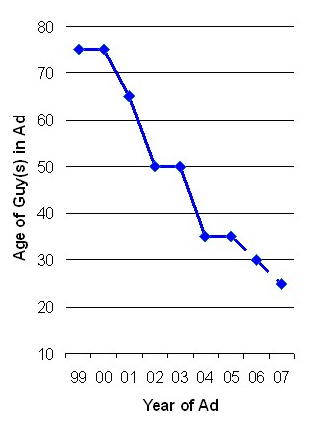Pushing the Envelope is Bad for DTC OpEd by John Mack
 Have you noticed that the men in the Direct-to-Consumer (DTC) ads for Cialis, Levitra, and Viagra are getting younger and younger?
Have you noticed that the men in the Direct-to-Consumer (DTC) ads for Cialis, Levitra, and Viagra are getting younger and younger?
The Viagra ads began by featuring Bob Dole, who was 76 at the time (1999). Levitra started out with Mike Ditka (age 65), while Viagra shifted to Joe, who is maybe 45 or 50. The Cialis guys in the bathtub and convertible also look about 45 to 50. But the new Levitra guy looks thirty-something. His wife — or is it just his “gal?” — is stunning and looks even younger!
I plotted this age trend (see chart) and predict that by 2006, the ads will show men and women in their twenties — hardly the demographic likely to be suffering from erectile dysfunction (ED).
There’s a one-upmanship game going on here, where one product takes it a step further than the other to push the envelope. Cialis began using couples in benign pseudo-sexual situations. You understood something was going to happen, but off-camera as it were. Viagra did this first, but in a much more subtle way without a lot of “touchy-feely” interactions.
Then, Levitra dumped Ditka and brought in a sexy brunette with poses straight from the Victoria’s Secret catalog (“my guy” ad). I am not sure how much more explicit the ads can become. The Levitra ad already talks about “improve[ing] erection quality… time and time again.”
Prurient interest aside, none of the ads provides much education about the indicated condition or who might suffer from it and benefit from seeking medical attention.
If the trend continues, lawmakers — some of whom already are gunning for DTC — are sure to take notice. In my opinion, ED product marketers should declare a moratorium on this ad “shoot out” before it is too late. It’s not doing anything to prove the argument that DTC is educational and it certainly is not sending the right message to the FDA, which just recently issued new guidances applauding the benefits of DTC advertising.
Vol. 3, No.5: May 2004
Word Count: n/a



![6 Digital Tools at the Center of Healthcare Digitalization [INFOGRAPHIC]](http://ec2-54-175-84-28.compute-1.amazonaws.com/pharma-mkting.com/wp-content/uploads/2021/04/6DigitalTools_600px-218x150.jpg)




![6 Digital Tools at the Center of Healthcare Digitalization [INFOGRAPHIC]](http://ec2-54-175-84-28.compute-1.amazonaws.com/pharma-mkting.com/wp-content/uploads/2021/04/6DigitalTools_600px-100x70.jpg)




